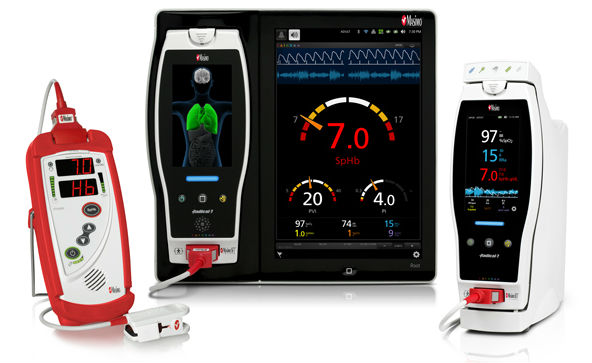Masimo announced that in a new study recently presented at the World Congress of Anesthesiologists (WCA) in Hong Kong, researchers concluded that continuous and noninvasive hemoglobin monitoring using Masimo SpHb may reduce excessive intraoperative red blood cell (RBC) transfusion.1
In a retrospective review of 371 patients who underwent intraoperative RBC transfusions between 2012 and 2014 at Fukushima Medical University in Japan, Dr. Imaizumi and colleagues compared 94 patients who had noninvasive hemoglobin measurements to 277 patients who did not (the control group). The total transfusion volumes and transfusion volume per 1g of blood loss were determined for each group.

Noninvasive and continuous hemoglobin (SpHb) monitoring offers real-time visibility to changes – or lack of changes – in hemoglobin between invasive blood sampling. (Photo courtesy of Masimo Corporation)
Comparing the groups, researchers noted that “a significantly lower mean RBC transfusion volume per 1g of blood loss was observed in the SpHb group compared with the [control] group (SpHb group, 0.9 ± 1.0 ml/g blood loss vs [control] group, 2.4 ± 5.9 ml/g blood loss, p < 0.01).”
They also observed that there was “no significant difference…in the average RBC transfusion volume (SpHb group, 815 ± 819 ml vs. [control] group, 785 ± 773 ml, p=0.75), or the preoperative hemoglobin concentration (SpHb group, 10.4 ± 1.9 g/dL vs. [control] group, 10.2 ± 2.4 g/dL, p=0.27) between the groups.” According to results from this abstract, the authors concluded that “SpHb measurements are associated with reducing excessive intraoperative RBC transfusion.”
“This is the third study, published by different researchers on three continents (US2, Egypt3, and now Japan1 ), that has shown that in addition to other clinical tools, SpHb may be used to help clinicians make informed transfusion decisions during different types of surgery*,” stated Dr. Steven Barker, Ph.D., M.D., chief science officer, Masimo.
SpHb monitoring may provide additional insight to the directional trend of hemoglobin between invasive blood samplings – when the SpHb trend is stable and the clinician may otherwise think hemoglobin is decreasing; when the SpHb trend is rising and the clinician may otherwise think hemoglobin is not rising fast enough; or when the SpHb trend is decreasing and the clinician may otherwise think hemoglobin is stable. SpHb with laboratory diagnostic test may thus help clinicians make more timely and informed decisions, and has been shown to help clinicians provide more timely blood transfusions* and reduce blood transfusions in cases such as neurosurgery and orthopedic surgery. 2,3
Last week Masimo announced that in response to the Zika virus and its potential impact on the availability of blood products, Masimo has created a special program to dramatically reduce the cost of and increase access to Masimo’s SpHb solutions, as SpHb has been shown to help clinicians reduce blood transfusions in both low and high blood loss surgery. This special program will be available wherever the blood supply is affected by the Zika virus.
—————————————————————–
*Clinical decisions regarding red blood cell transfusions should be based on the clinician’s judgment considering, among other factors: patient condition, continuous SpHb monitoring, and laboratory diagnostic tests using blood samples.
References
- Imaizumi et al. Continuous and noninvasive hemoglobin monitoring may reduce excessive intraoperative RBC transfusion. Proceedings from the 16th World Congress of Anaesthesiologists, Hong Kong. Abstract #PR607.
- Ehrenfeld JM et al. J Blood Disorders Transf. 2014. 5:9. 2.
- Awada WN et al. J Clin Monit Comput. 2015 Feb 4.




